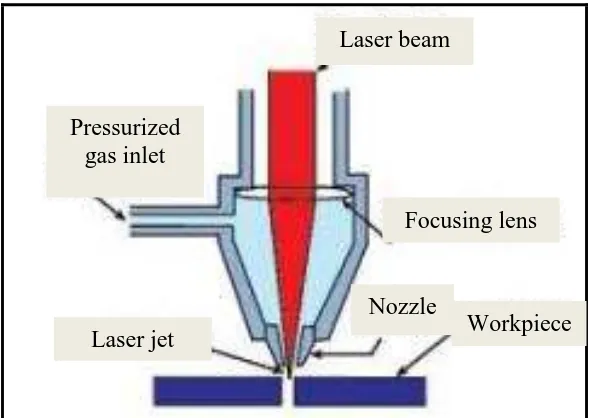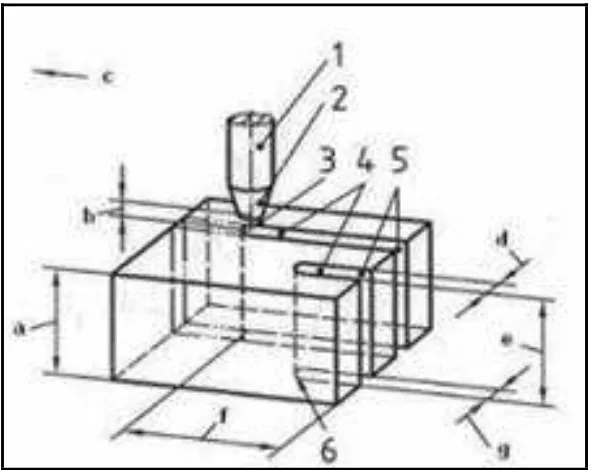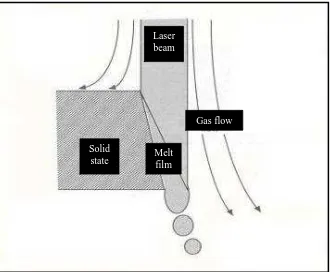UNIVERSITI TEKNIKAL MALAYSIA MELAKA
CO
2LASER CUTTING OF POLYPROPYLENE POLYMER
This report submitted in accordance with requirement of the Universiti Teknikal Malaysia Melaka (UTeM) for the Bachelor Degree of Manufacturing Engineering
(Manufacturing Process) with Honours.
by
SITI HAZA BINTI HASAN
oval
UTeM Library (Pind.1/2005)
UNIVERSITI TEKNIKAL MALAYSIA MELAKA (UTeM)
BORANG PENGESAHAN STATUS TESIS*
JUDUL: CO2 LASER CUTTING OF POLYPROPYLENE POLYMER
SESI PENGAJIAN: 2008/2009
Saya SITI HAZA BINTI HASAN
mengaku membenarkan tesis (PSM/Sarjana/Doktor Falsafah) ini disimpan di Perpustakaan Universiti Teknikal Malaysia Melaka (UTeM) dengan syarat-syarat kegunaan seperti berikut:
1. Tesis adalah hak milik Universiti Teknikal Malaysia Melaka.
2. Perpustakaan Universiti Teknikal Malaysia Melaka dibenarkan membuat salinan untuk tujuan pengajian sahaja.
3. Perpustakaan dibenarkan membuat salinan tesis ini sebagai bahan pertukaran antara institusi pengajian tinggi.
* Tesis dimaksudkan sebagai tesis bagi Ijazah Doktor Falsafah dan Sarjana secara penyelidikan, atau disertasi bagi pengajian secara kerja kursus dan penyelidikan, atau Laporan Projek Sarjana Muda (PSM). ** Jika tesis ini SULIT atau TERHAD, sila lampirkan surat daripada pihak berkuasa/organisasi berkenaan dengan menyatakan sekali sebab dan tempoh tesis ini perlu dikelaskan sebagai SULIT atau TERHAD.
DECLARATION
I hereby, declared this reported entitled “CO2 Laser Cutting of Polypropylene Polymer” is the
results of my own research expect as cited in references.
Signature
Author‟s Name
APPROVAL
ABSTRACT
Laser cutting is a technology that uses a laser to cut materials, and is typically used for industrial manufacturing applications. Laser cutting works by directing the output of a high power laser, by computer, at the material to be cut. The material then either melts, burns, vaporizes away, or is blown away by a jet of gas, leaving an edge with a high quality surface finish. This study is focusing on CO2 laser cutting process on
ABSTRAK
DEDICATION
To my beloved father, Hasan bin Saman and mother, Che Esah binti
Abdullah for all support that you have given to me.
For my supervisor, En Mohmad Nizam bin Ayof and all my fellow
friends especially Muhammad Qusyairi Abdul Rahman whom never
give up in supporting and encouraging me.
ACKNOWLEDGEMENT
I am very thankful to Allah S.W.T as I finally finished my project paper with all His blessing and granting me with the strength and wisdom to face all the challenges during the accomplishment of this project. For about two semesters doing this project, there are so many obstacles that i have been through and all these experiences are very useful to me in gaining the new knowledges.
TABLE OF CONTENTS
2.1 Principles of Laser Cutting 5 2.2 Types of Laser Cutting 8 2.3.3 Laser processing on PP plastic sheet 16
2.5.2 Cutting Speed 19
2.5.3 Laser power 20
2.6. Cutting quality 21
2.6.1 Surface Roughness 21
2.6.2 Basic rules affecting cut quality 23
2.6.2.1 The edge finish 23
2.6.2.2 Thickness of material 25
2.6.2.3 Power variations 25
2.6.2.4 Beam quality 25
2.6.2.5 High-energy density beams 25
2.6.2.6 Speed of cut 25
2.6.2.7 Exhaust of smoke and vapor 26 2.7 Considerations in laser cutting 26 2.7.1 Primary Considerations in Laser Processing 26
2.7.1.1 Absorption of material 27
2.7.1.2 Thermal diffusity 27
2.7.1.3 Reaction temperature 27
2.7.2 Secondary considerations in laser cutting 27
3.5 Methodology for DOE 34
3.5.1 Define the Objective 34
3.5.2 Identification of Design Factor and Level 34 3.5.3 Identify suitable Response Variable 35
3.5.4 Preparation of Experiment 35
3.5.5 Performing the trial Experiment and Actual experiment 36 3.5.6 Analyze and interpret results of experiment run 37
3.6 Project Flow Chart 39
4.0 CHAPTER 4: DISCUSSION 41
APPENDICES
A Gantt Chart PSM 1 B Gantt Chart PSM 2
C Minitab Session for Surface Roughness Analysis D Minitab Session for Burr Width Analysis
LIST OF TABLE
3.1 The parameter used with two level designs 35 3.2 Two-level 3-Factor Full-Factorial Experiment Design Pattern 35
4.1 DOE matrix for two-level factorial design 45 4.2 Main effects plot for surface roughness 51
4.3 The data of average burr width 60
LIST OF FIGURES
2.1 Basic principle of laser cutting 6 2.2 Basic principle of laser cutting 6 2.3 The term related to cutting process of workpiece 7 2.4 A sketch of laser fusion cutting 9 2.5 A sketch of laser oxygen cutting 10 2.6 A sketch of vaporization cutting 11
2.7 Micrograph of polypropylene 15
2.8 The position of focusing lens and the focal distance 19
2.9 Mean height of the profile 22
2.10 Characteristics of surface roughness 22 2.11 Laser processing of material 26
2.12 Heat affected zone 27
3.1 The dimension of PP that will be used 36 3.2 HELIUS 2513 CO2 laser machine 37
3.3 The way to cutting the PP 37
3.4 Portable roughness measuring machine with probe 38 3.5 Zeiss Microscope Axioskop Two Mat 38
4.1 The PP sheet that cut by CO2 laser cutting 41 4.2 The defect found by laser cutting process 42
4.3 Side view of specimens 43
4.4 The microscopic view of 4X zoom for specimen 1 to 8 44 4.5 Normal probability plot of the standardized effects for surface roughness 46 4.6 Pareto chart of the standardized effects for surface roughness 47
CHAPTER 1
INTRODUCTION
1.1 Background of Study
Laser cutting has developed into state- of- art technology over the past decade. There are so many cutting systems that used for the high- power cutting of metals and non-metals material. By the using of low power applications, this system is used widely in plastics cutting and paper cutting.
Many lasers can be used for laser cutting by providing their beam which focused on a small spot with sufficient intensity to melt the material and their specific wavelength is absorbed in the material. CO2 gas lasers, Nd: YAG solid-state lasers and Excimer gas
lasers are those most commonly used in the field of materials processing. However, knowing the strengths and weaknesses of laser processing is the key to determining whether or not a laser is the right choice for cutting. While lasers are not the answer for every application, they can provide flexibility, efficient material use, a repeatable and controlled process.
In CO2 laser gas-assisted cutting process, modeling of the interaction mechanism is
optimum combination between the parameters involved in this project. Besides, through this finding, the main effect factors and the interaction between each factor also can be identified.
1.2 Problem Statement
The problem encountered in doing this project is to get the optimum combination of parameters in order to get the good quality of laser cutting process which will give the smaller value of Ra, which means that the cut quality is good.
Rajaram et al. (2003) said that, compared with other conventional mechanical processes, laser cutting removes little material, involves highly localized heat input to the workpiece, minimizes distortion, and offers no tool wear. Of particular interest to manufacturers using laser cutting are the maximization of the productivity and the subsequent quality of components made by the laser cutting process. Both aspects are governed by the selection of appropriate laser process parameters, which are unique for each material and thickness. These parameters include laser power, frequency, duty cycle, standoff height, and cutting speed and assist gas pressure. These parameters are usually adjusted and tuned to provide the quality of cut desired, but this consumes exhaustive amounts of time and effort, and still good quality cutting conditions may not be found. If a different type of material is to be cut, then the procedure has to be repeated.
By the laser cutting application, it can be seen that there are so many advantages of laser cutting over the mechanical cutting according to the situation. However, there are two important factors which are the lack of physical contact (since there is no cutting edge which can become contaminated by the material or contaminate the material), and to some extent precision (since there is no wear on the laser). There is also a reduced chance of warping the material that is being cut, as laser systems have a small heat-affected zone.
The other difference that lasers have over conventional processes such as stamping and punching is that they work with minimal contact. A typical cut width enables lasers to be used for small-radius cutting. This small kerf allows close nesting of parts and helps to minimize material waste. In addition, materials may be heat treated after cutting without the distortion that can occur with the grinding and reforming usually needed after processing by other methods.
This study is focusing on research to investigate the best combination of parameters that used in CO2 laser cutting process in cutting the thermoplastic polymer which is value of Ra by CO2 laser cutting process
1.4 Scopes of Study
This research project will focus primarily on application of CO2 laser cutting on
thermoplastic polymer (polypropylene), the effect of different parameters setting during the process, and also about the surface roughness of product that have been cut by using CO2 laser cutting process. This project also to investigate which factors that give the
CHAPTER 2
LITERATURE REVIEW
2.1 Principles of Laser Cutting
Petring (2001) in his research states that laser cutting is a thermal cutting process in which a cut kerf (slot) is formed by the heating action of a focused traversing laser beam of power density in combination with the melt shearing action of a stream of inert or active assist gas. The focused laser beam melts the material throughout the material thickness and a pressurized gas jet, acting coaxially with the laser beam, which blows away the molten material from the cut kerfs.
The basic principle of laser cutting is shown in Figure 2.1 and Figure 2.2, and the terms related to the cutting process are illustrated in Figure 2.3.
Figure 2.1: Principle of laser cutting (Berkmanns and Mark, n.d)
Figure 2.2: Basic principle of laser cutting
Pressurized gas inlet
Laser beam
Focusing lens
Laser jet
Nozzle
Figure 2.3: The term related to cutting process of workpiece (Lappeenranta, 2006)
The term related to cutting process:
1 Torch a Workpiece thickness
2 Nozzle b Nozzle distance
3 Beam c Cutting direction
4 Kerf d Top kerf width
5 Start of cut e Cut thickness
6 End of cut f Length of cut
g Bottom kerf width
Whether laser cutting with CO2 or Nd: YAG lasers, the principles employed are
basically the same. The beam from the laser is focused on to the surface of the material being cut by means of a lens. The focused laser beam heats the material surface and a very local melt capillary is quickly established throughout the depth of the material. The diameter of this capillary is usually just slightly greater than the diameter of the focused laser beam. The great majority of CO2 laser cutting is performed using an assist gas. The
significant feature of gas assisted laser cutting is that the molten material is ejected from the base of the capillary by a jet of gas coaxial with the laser beam. For some materials this gas can further assist the process by chemical (exothermic) reaction as well as physical work. The cut is generated by either moving the focused laser beam across the surface of the stationary material or by keeping the laser beam stationary or moving the workpiece. Hybrids of these two options are also possible. In this way simple and complex linear cuts or two dimensional parts can be produced. More complex systems are required for three dimensional processing. Most lasers cutting with CO2 lasers are
performed in the power range 1 - 1.5kW. However, over the last few years higher beam quality lasers with powers up to 6kW have become available and these lasers have been able to extend the thickness cut, on steel for example, to 20 - 25mm (Petring, 2001).
2.2 Types of Laser Cutting
2.2.1 Laser fusion cutting
Figure 2.4: A sketch of laser fusion cutting
Laser fusion cutting is applicable to all metals especially stainless steels and other highly alloyed steels, aluminum and titanium alloys. A high quality cut edge is formed but the cutting speeds are relatively low in comparison with active gas cutting mechanisms. This view has been supported in the work of Ion (n.d). The advantage of this process is that the resulting cut edges are free of oxides and have the same corrosion resistance as the substrate. The cut edges may be welded without any post-cutting preparation. The main technical demand is to avoid adherent melt (dross attachment) at the bottom edges of the kerf. A high pressure (above 10 bars) is recommended to remove liquid that can adhere to the underside and solidify as dross. (Natarajan, 1990)
2.2.2 Laser oxygen cutting


